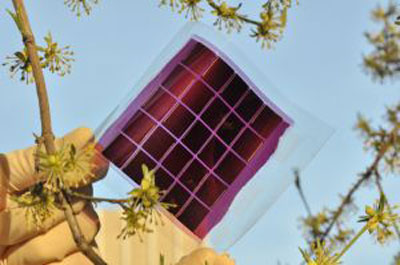| Jul 03, 2012 |
Solar power from plastic foils
|
|
(Nanowerk News) KIT intensifies printable organic solar cell research. A group of researchers headed by Dr. Alexander Colsmann at the Light Technology Institute (LTI) will start work this month. The project is scheduled for a duration of four years and aims at enhancing the efficiency of organic solar cells to more than 10%. For this purpose, the researchers use tandem architectures combining solar cells of complementary absorption spectra. The Federal Ministry of Education and Research has granted funding of EUR 4.25 million.
|
 |
| Flexible organic solar module on a plastic foil made by KIT.
|
|
The new generation of solar cells is light, flexible, semi-transparent, and allows for a low-cost production. Organic solar cells (plastic solar cells) can be applied to surfaces of nearly any shape by state-of-the-art printing and coating processes. Organic photovoltaics open up new perspectives in particular for the architectural design of buildings. The solar modules can be integrated in facades and even windows. In addition, they open up new OEM applications in the automotive or consumer sectors.
|
|
Organic solar cells are fabricated by low-cost printing and coating processes, such as gravure printing, screen printing, slot-die coating or spray coating in continuous roll-to-roll processes. Plastic carriers provide for the mechanical flexibility of the modules. At the same time, organic solar cells are characterized by an extremely low consumption of environmentally compatible resources, unprob-lematic disposal, and a very short energy payback time.
|
|
Still, organic solar cells exhibit moderate power conversion efficien-cies only. For them to be able to compete with established inorganic solar cells, extensive research is required. The early career scientists in the team of Dr. Alexander Colsmann, KIT, use so-called tandem architectures. Two solar cells with complementary absorption characteristics are stacked directly on top of each other to achieve better sunlight harvesting and more efficient energy conversion. The KIT scientists use novel materials, develop innovative device architectures, optimize their stability, and test the solar cells in a real-life environment. Moreover, they transfer man-ufacturing processes from the laboratory to an industry-compatible production environment in order promote future commercial use of their results.
|
|
“The funding of EUR 4.25 million granted by the Federal Ministry of Education and Research (BMBF) reflects the quality of our work,” Colsmann says. He heads the Organic Photovoltaics Group at the Light Technology Institute of KIT.
|
|
In this project the KIT researchers are supported by the Fraunhofer Institute for Applied Polymer Research (IAP), Potsdam, represented by Dr. Hartmut Krüger, and the University of Queensland/Australia, represented by Professor Paul Burn, who supply new materials for organic solar cells. Merck KGaA is the industry advisor of the project.
|

